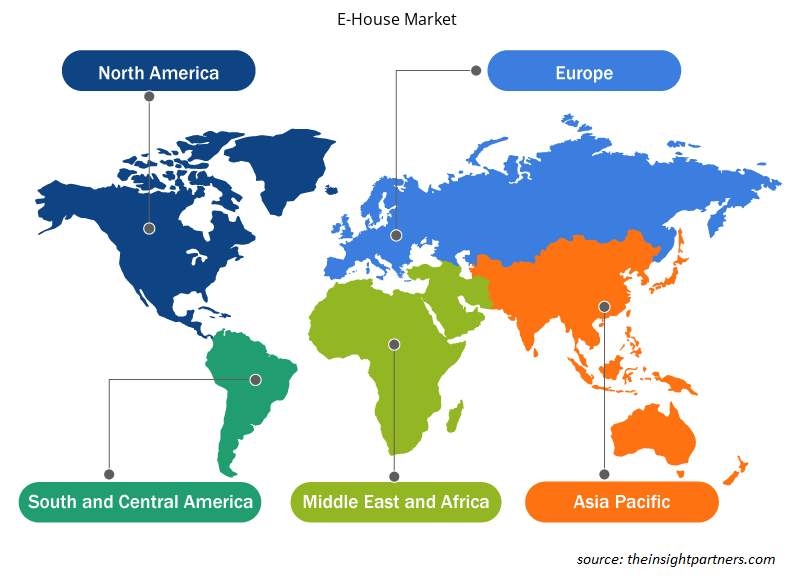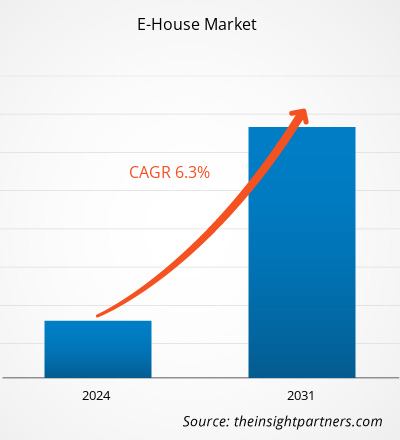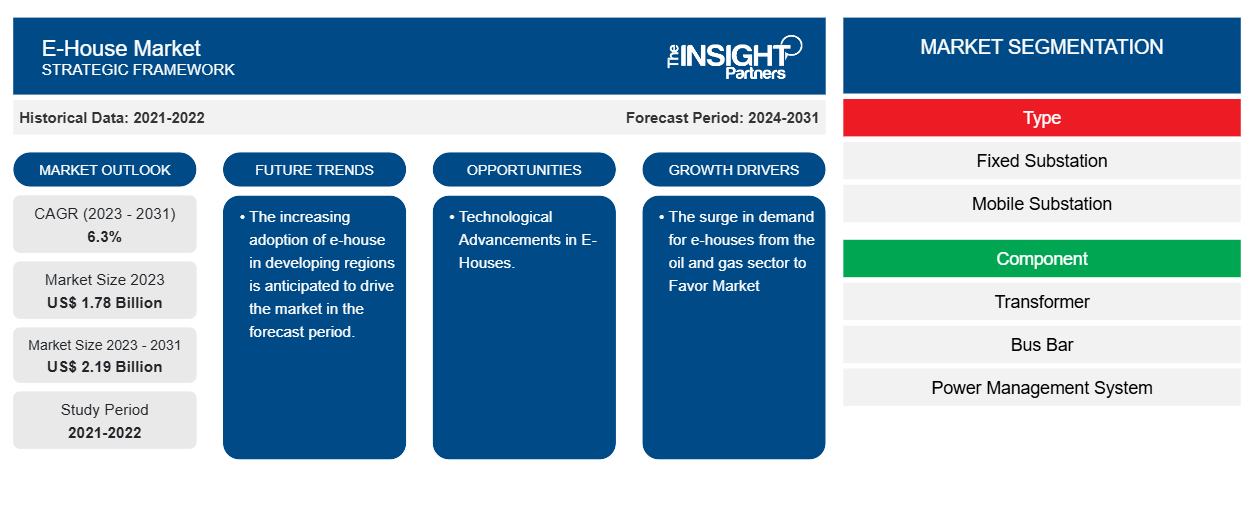Se proyecta que el tamaño del mercado de las casas eléctricas alcance los 2.910 millones de dólares en 2031, frente a los 1.780 millones de dólares en 2023. Se espera que el mercado registre una CAGR del 6,3 % durante el período 2023-2031. La facilidad de instalación, la rentabilidad y la flexibilidad de las casas eléctricas, así como el aumento de la demanda de estas casas en el sector del petróleo y el gas, probablemente sean los principales impulsores y tendencias del mercado de las casas eléctricas.CAGR of 6.3% during 2023–2031. The ease of installation, cost-effectiveness, and flexibility of the E-House and the surge in demand for
Análisis del mercado de casas electrónicas
El mercado de las casas eléctricas está experimentando un crecimiento significativo a nivel mundial. Este crecimiento se atribuye a la facilidad de instalación, la rentabilidad y la flexibilidad de las casas eléctricas y al aumento de la demanda de casas eléctricas en el sector del petróleo y el gas. Además, se prevé que la adopción de las casas eléctricas en las regiones en desarrollo y los avances tecnológicos ofrezcan varias oportunidades en los próximos años.
Panorama general del mercado de casas electrónicas
Las E-houses son subestaciones prefabricadas que se utilizan como centros de distribución de energía. Estas subestaciones en contenedores proporcionan salas de distribución según sea necesario. Para aplicaciones especiales, como centros de datos, se pueden proporcionar plataformas para una implementación rápida. Las E-Houses móviles se instalan en remolques como subestaciones portátiles.switchgear rooms as required. For special applications like Datacenters skids can be provided for rapid deployment. Mobile E-Houses are installed on trailers as portable substations.
Personalice este informe según sus necesidades
Obtendrá personalización en cualquier informe, sin cargo, incluidas partes de este informe o análisis a nivel de país, paquete de datos de Excel, así como también grandes ofertas y descuentos para empresas emergentes y universidades.
- Obtenga las principales tendencias clave del mercado de este informe.Esta muestra GRATUITA incluirá análisis de datos, desde tendencias del mercado hasta estimaciones y pronósticos.
Factores impulsores y oportunidades del mercado de casas electrónicas
El aumento de la demanda de casas electrónicas en el sector del petróleo y el gas favorece al mercado.
Las E-Houses móviles se instalan en remolques como subestaciones portátiles. Todos los tipos de E-Houses pueden resolver diversos desafíos de proyectos y respaldar objetivos de sostenibilidad comunes. Las E-Houses se implementan en instalaciones de petróleo y gas upstream, midstream y downstream. Albergan equipos para la distribución de energía, sistemas de control e instrumentación críticos para la extracción, procesamiento y transporte de petróleo y gas. Las E-Houses se utilizan ampliamente en la industria del petróleo y el gas y la minería y cada vez con más frecuencia para la instalación de equipos en otros sectores. Por lo tanto, considerando los parámetros anteriores, el aumento en la demanda de E-House del sector del petróleo y el gas está impulsando el mercado.
Avances tecnológicos en las casas electrónicas.
Se prevé que el avance tecnológico en las casas eléctricas impulse el mercado en los próximos años. El mercado ha experimentado avances tecnológicos significativos en los últimos años. Estos avances están impulsados por la necesidad de soluciones energéticas más eficientes, confiables y adaptables en una variedad de sectores. Varias empresas ofrecen soluciones de casas eléctricas tecnológicamente avanzadas. Por ejemplo, Kontrolmatik se mantiene a la vanguardia de los avances tecnológicos en el diseño de casas eléctricas. La empresa integra las últimas tecnologías inteligentes, soluciones de eficiencia energética y sistemas de control avanzados para brindar soluciones de vanguardia a sus clientes. Por lo tanto, se prevé que los avances tecnológicos en las casas eléctricas impulsen el crecimiento del mercado en los próximos años.Kontrolmatik stays at the forefront of technological advancements in E-House design. The company integrates the latest smart technologies, energy-efficient solutions, and advanced control systems to provide cutting-edge solutions to its clients. Thus, the technology advancements in the e-houses are anticipated to drive market growth in the coming years.
Análisis de segmentación del informe del mercado de casas electrónicas
Los segmentos clave que contribuyeron a la derivación del análisis del mercado de casas electrónicas son el tipo, el componente y las aplicaciones.
- Según el tipo, el mercado de las casas eléctricas se divide en subestaciones fijas y subestaciones móviles. Se prevé que el segmento de las subestaciones fijas ocupe una cuota de mercado significativa en el período de previsión.
- Según los componentes, el mercado de las casas eléctricas se divide en transformadores, barras colectoras, sistemas de gestión de energía, variadores de frecuencia, cuadros de distribución, sistemas de climatización y otros. Se prevé que el segmento de transformadores ocupe una cuota de mercado significativa en el período de previsión.switchgear, HVAC, and others. The transformer segment is anticipated to hold a significant market share in the forecast period.
- Por aplicación, el mercado se segmenta en industria y servicios públicos. Se prevé que los servicios públicos tengan una participación de mercado significativa en el período de pronóstico.
Análisis de la cuota de mercado de los e-House por geografía
El alcance geográfico del informe del mercado de casas electrónicas se divide principalmente en cinco regiones: América del Norte, Asia Pacífico, Europa, Medio Oriente y África, y América del Sur y Central.
El mercado de las casas electrónicas ha estado dominado por América del Norte, que está segmentado en Estados Unidos, Canadá y México. Las tendencias de adopción de alta tecnología en diversas industrias de la región de América del Norte han impulsado el crecimiento de este mercado. Se espera que factores como la mayor adopción de herramientas digitales y el elevado gasto tecnológico por parte de las agencias gubernamentales impulsen el crecimiento del mercado norteamericano de las casas electrónicas. Además, el fuerte énfasis en la investigación y el desarrollo en las economías desarrolladas de Estados Unidos y Canadá está obligando a los actores norteamericanos a introducir en el mercado soluciones tecnológicamente avanzadas. Además, Estados Unidos cuenta con un gran número de actores del mercado de las casas electrónicas que se han centrado cada vez más en el desarrollo de soluciones innovadoras. Todos estos factores contribuyen al crecimiento del mercado de las casas electrónicas en la región.fuelled the growth of the e-house market. Factors such as increased adoption of digital tools and high technological spending by government agencies are expected to drive the North American e-house market growth. Moreover, a strong emphasis on research and development in the developed economies of the US and Canada is forcing the North American players to bring technologically advanced solutions into the market. In addition, the US has a large number of e-house market players who have been increasingly focusing on developing innovative solutions. All these factors contribute to the region's growth of the e-house market.
Perspectivas regionales del mercado de casas electrónicas
Los analistas de Insight Partners explicaron en detalle las tendencias y los factores regionales que influyen en el mercado de casas electrónicas durante el período de pronóstico. En esta sección también se analizan los segmentos y la geografía del mercado de casas electrónicas en América del Norte, Europa, Asia Pacífico, Oriente Medio y África, y América del Sur y Central.

- Obtenga los datos regionales específicos para el mercado de E-House
Alcance del informe sobre el mercado de casas electrónicas
| Atributo del informe | Detalles |
|---|---|
| Tamaño del mercado en 2023 | 1.780 millones de dólares estadounidenses |
| Tamaño del mercado en 2031 | US$ 2,19 mil millones |
| CAGR global (2023 - 2031) | 6,3% |
| Datos históricos | 2021-2022 |
| Período de pronóstico | 2024-2031 |
| Segmentos cubiertos | Por tipo
|
| Regiones y países cubiertos | América del norte
|
| Líderes del mercado y perfiles de empresas clave |
|
Densidad de actores del mercado de e-House: comprensión de su impacto en la dinámica empresarial
El mercado de las casas electrónicas está creciendo rápidamente, impulsado por la creciente demanda de los usuarios finales debido a factores como la evolución de las preferencias de los consumidores, los avances tecnológicos y una mayor conciencia de los beneficios del producto. A medida que aumenta la demanda, las empresas amplían sus ofertas, innovan para satisfacer las necesidades de los consumidores y aprovechan las tendencias emergentes, lo que impulsa aún más el crecimiento del mercado.
La densidad de actores del mercado se refiere a la distribución de las empresas o firmas que operan dentro de un mercado o industria en particular. Indica cuántos competidores (actores del mercado) están presentes en un espacio de mercado determinado en relación con su tamaño o valor total de mercado.
Las principales empresas que operan en el mercado de E-House son:
- ABB Ltd
- Comer
- Becker Mining Systems AG
- Schneider Electric SE
- Siemens AG
- NOSOTROS
Descargo de responsabilidad : Las empresas enumeradas anteriormente no están clasificadas en ningún orden particular.

- Obtenga una descripción general de los principales actores clave del mercado de E-House
Noticias y desarrollos recientes del mercado de casas electrónicas
El mercado de las casas electrónicas se evalúa mediante la recopilación de datos cualitativos y cuantitativos a partir de investigaciones primarias y secundarias, que incluyen importantes publicaciones corporativas, datos de asociaciones y bases de datos. A continuación se enumeran algunos de los avances en el mercado de las casas electrónicas:
- Hartek Power se asoció con TP Western Odisha Distribution Limited (TPWODL), una empresa conjunta de TATA Power y Odisha Distribution Limited, para adquirir dos nuevas subestaciones eléctricas en contenedores de 33/11 KV con un valor de 2,99 millones de dólares estadounidenses, llave en mano. (Fuente: sitio web de Hartek Power Company, agosto de 2023)
Informe sobre el mercado de E-House: cobertura y resultados
El informe “Tamaño y pronóstico del mercado de E-House (2021-2031)” proporciona un análisis detallado del mercado que cubre las siguientes áreas:
- Tamaño del mercado de casas electrónicas y pronóstico a nivel global, regional y nacional para todos los segmentos clave del mercado cubiertos bajo el alcance
- Tendencias del mercado de casas electrónicas, así como dinámicas del mercado, como impulsores, restricciones y oportunidades clave
- Análisis detallado de las cinco fuerzas de Porter y PEST y FODA
- Análisis del mercado de casas electrónicas que abarca las tendencias clave del mercado, el marco global y regional, los principales actores, las regulaciones y los desarrollos recientes del mercado
- Análisis del panorama de la industria y de la competencia que cubre la concentración del mercado, el análisis de mapas de calor, los actores destacados y los desarrollos recientes en el mercado de casas electrónicas.
- Perfiles detallados de empresas
- Análisis histórico (2 años), año base, pronóstico (7 años) con CAGR
- Análisis PEST y FODA
- Tamaño del mercado, valor/volumen: global, regional y nacional
- Industria y panorama competitivo
- Conjunto de datos de Excel
Informes recientes
Testimonios
Razón para comprar
- Toma de decisiones informada
- Comprensión de la dinámica del mercado
- Análisis competitivo
- Información sobre clientes
- Pronósticos del mercado
- Mitigación de riesgos
- Planificación estratégica
- Justificación de la inversión
- Identificación de mercados emergentes
- Mejora de las estrategias de marketing
- Impulso de la eficiencia operativa
- Alineación con las tendencias regulatorias





















 Obtenga una muestra gratuita para - Mercado de casas electrónicas
Obtenga una muestra gratuita para - Mercado de casas electrónicas